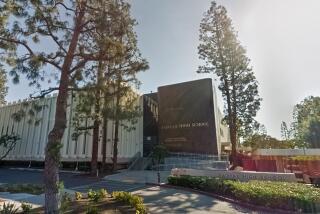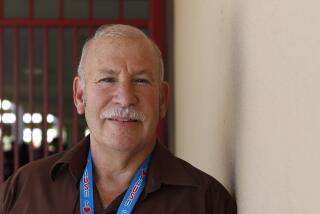L.A. Unified says it can’t afford ‘computer for all’ plan

Los Angeles Unified schools Supt. Ramon C. Cortines said Friday that the district cannot afford to provide a computer to every student, signaling a major reversal of his predecessor’s ill-fated $1.3-billion effort to distribute iPads to all students, teachers and school administrators.
Instead, Cortines said, the L.A. Unified School District will try to provide computers to students when they are needed for instruction and testing.
“I don’t believe we can afford a device for every student,” Cortines said. “Education shouldn’t become the gimmick of the year.”
For former Supt. John Deasy, who resigned under pressure in October, the ambitious iPad plan was a signature initiative. It generated national attention and fueled debate about how best to get the latest technology to students in less affluent areas.
But Cortines said Friday that the reality was that the district never fully prepared for how the devices would be used in the classroom or how to pay for them over time.
Cortines laid out a more measured approach, saying purchasing computers needed to be balanced against other priorities such as repairing dilapidated campuses.
The initial rollout of iPads at 47 schools in the fall of 2013 was plagued by problems. One of the first occurred when high school students deleted security filters so they could freely browse websites. Later, questions arose about close professional relationships that Deasy and his senior deputy, Jaime Aquino, developed with executives from Apple, maker of the iPad, and Pearson, which provided the curriculum on the device. In December, the FBI seized documents related to the project as part of a criminal investigation into the bidding process.
Deasy and other officials have denied any wrongdoing and, all along, the former superintendent insisted it was a civil rights and educational imperative to make technology available to all students.
The district’s iPad problems have come up repeatedly in the run-up to the March 3 school board elections, with most challengers faulting the incumbents for going along with the flawed effort.
Among the incumbents on the ballot, Tamar Galatzan was the most vocal backer of Deasy’s iPad plan, which passed without opposition in 2013.
“At the time the board was told we could afford to get there,” she said Friday. “There were phases in a plan and we were told we had the money” to provide the devices to all students.
“That’s so far in the past,” she said.
Galatzan remains steadfast in her belief that students should be equipped with computers.
“Our goal is to get one device for every student, but that’s our long-term goal,” she said.
“Our short-term goal is to make sure every student has access to a computer to complete classroom assignments, and so the teachers can use them in class,” she said.
Board member Monica Ratliff was among the first to raise questions about the project in a technology committee she headed.
She praised Cortines for “taking the issues of the project’s cost and sustainability seriously.”
The superintendent recently alerted the board to his concerns about the technology program, said member Steve Zimmer. He has said that he and his colleagues should have more closely scrutinized the project from the start.
“We’ve evolved from an idea that I initially supported strongly and now have deep regrets about,” he said. “But I don’t have regrets about the effort to bridge the technology gap.”
Closing that gap was a focus of the former superintendent when he announced in 2012 that he planned to provide a tablet to every student. A bidding process for the project came together quickly in early 2013.
Deasy’s original goal was to distribute all the iPads within 18 months. That never happened because of technical problems, district missteps and eroding political support.
By 2014, Deasy accepted that the board would move more slowly and in a new direction, including the option for schools to use devices other than an iPad.
From the start, the funding source was school construction bonds — a strategy that survived legal review but which has been widely criticized.
Cortines touched on that issue in a statement: “There must be a balanced approach to spending bond dollars to buy technology when there are so many brick and mortar and other critical facility needs that must be met.”
In a wide-ranging conversation with reporters Friday, Cortines said he intends to bring forward a $1-billion plan to upgrade some of the district’s oldest campuses, which also would be funded with bond money.
The district already has purchased more than 120,000 iPads and more than 18,000 laptops, which should help the school system make the switch to new state standardized tests, which are given on computer. The new testing requirements were another motivating factor for Deasy and his team.
Cortines, who came out of retirement to take over for Deasy, said a task force would meet to help plot the future path on technology.
Another of Deasy’s major efforts was a teacher evaluation system that relied in part on students’ standardized test scores as one measure of instructors’ effectiveness. The plan emerged out of a court battle with the teachers’ union. A judge ruled that test scores had to be included in those reviews, citing California law. The union later won a ruling asserting that L.A. Unified had to negotiate over how test scores would be used.
Cortines said he wants an evaluation process that teachers support and that he is negotiating the performance review plan as part of ongoing talks.
He also reiterated the position that the salary demands of teachers (8.5%) are more than the district can afford. The teachers’ union this week declared an impasse in bargaining, which will lead to the appointment of a mediator, a step both sides say they support.
The superintendent also chided his bosses, saying the school board had approved proposals and programs without identifying the money to pay for them. The result, he said, contributed to the district’s long-term budget woes.
Deasy had repeatedly raised similar concerns.
howard.blume@latimes.com
More to Read
Start your day right
Sign up for Essential California for news, features and recommendations from the L.A. Times and beyond in your inbox six days a week.
You may occasionally receive promotional content from the Los Angeles Times.






